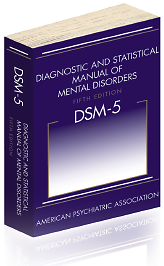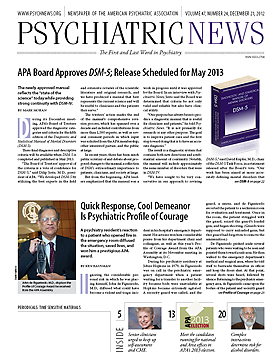During its December meeting, APA’s Board of Trustees approved the diagnostic categories and criteria for the fifth edition of the Diagnostic and Statistical Manual of Mental Disorders (DSM-5).
These final diagnoses and descriptive criteria will be available when DSM-5 is completed and published in May 2013.
“The Board of Trustees’ approval of the criteria is a vote of confidence for DSM-5,” said Dilip Jeste, M.D., president of APA. “We developed DSM-5 by utilizing the best experts in the field and extensive reviews of the scientific literature and original research, and we have produced a manual that best represents the current science and will be useful to clinicians and the patients they serve.”
The trustees’ action marks the end of the manual’s comprehensive revision process, which has spanned over a decade and included contributions from more than 1,500 experts, as well as several comment periods in which input was solicited from the APA membership, other interested parties, and the public at large.
In recent years, there has been much public scrutiny of and debate about proposed changes to the manual, a reflection of DSM’s extraordinary importance to patients, clinicians, and society at large.
But from the beginning, APA leaders emphasized that the manual was a work in progress until it was approved by the Board. In an interview with Psychiatric News, Jeste said the Board was determined that criteria be not only valid and reliable but also have clinical utility.
“Our purpose has always been to produce a diagnostic manual that is useful for clinicians and patients,” he told Psychiatric News. “It is not primarily for research or any other purpose. The goal is to improve patient care and the first step toward doing that is to have an accurate diagnosis.”
The result is a diagnostic system that contains both new directions and a substantial amount of continuity. Notably, the manual will include approximately the same number of disorders that were in DSM-IV.
“We have sought to be very conservative in our approach to revising DSM-5,” said David Kupfer, M.D., chair of the DSM-5 Task Force, in a statement released after the Board’s vote. “Our work has been aimed at more accurately defining mental disorders that have a real impact on people’s lives, not expanding the scope of psychiatry.”
Axis System Eliminated
DSM-5 will be composed of three sections: Section 1 will offer an introduction to DSM-5 with information on how to use the updated manual. Section 2 will outline the categorical diagnoses. Section 3 will include conditions that require further research before their consideration as formal disorders, as well as cultural concepts of distress and other information.
One crucial overarching change is the elimination of the multiaxial system that had placed diagnoses such as depression, anxiety, bipolar, and schizophreniaon Axis I and personality disorders on Axis II. That division had reflected, in part, a belief that Axis I disorders were “biological” in origin while personality disorders were more likely to be the result of psychosocial or environmental causes.
But enormous amounts of research now indicate that personality disorders, like most disorders formerly on Axis I, are brain disorders, and the elimination of the axis system reflects that understanding.
Some of the major changes or additions to specific diagnostic criteria include the following:
Autism, Asperger’s syndrome, and pervasive developmental disorder-not otherwise specified replaced by autism spectrum disorder.
Changes to posttraumatic stress disorder that include elimination of previously existing criteria requiring a “subjective reaction” to trauma and the expansion of symptom clusters to include re-experiencing, avoidance, and persistent negative alterations in cognitions and mood.
Elimination of the so-called “grief exclusion.” In DSM-IV there was an exclusion criterion for a major depressive episode when depressive symptoms lasted less than two months following the death of a loved one. This exclusion is omitted in DSM-5 and reflects the recognition that bereavement is a severe psychosocial stressor that in some cases can precipitate a major depressive episode in an individual, generally beginning soon after the loss.
Clinician-rated measures of suicide risk. Suicidality represents a critical concern in almost all diagnostic encounters in psychiatry, and clinicians are asked to inquire about suicidal thinking and plans and to rate the severity of suicide risk to make an explicit determination of the proportion of treatment planning that should be devoted to prevention of suicide in a given patient.
On to the Future
Some important and much discussed proposed changes did not make it into Section 2 of the manual, but were placed in Section 3, indicating a need for further research. Among these are attenuated psychosis syndrome (APS), a diagnosis intended to capture individuals who are at risk for psychosis but not yet acutely psychotic.
Jeste said the Board determined that APS was “not quite ready for prime time in terms of routine clinical use.” He said advocates for the diagnosis in the research field have argued that it would allow clinicians to identify and treat at-risk individuals using largely psychosocial treatments. But Jeste said there is the possibility that “some clinicians who are not expert in this area would apply the diagnosis to individuals with severe behavioral disorders and treat with antipsychotics.”
He added, “Moreover, there has not been any definitive evidence that such a diagnosis would actually lower the incidence of psychosis,” he said.
Jeste said the newly approved manual reflects the “state of the science” today and represents a continuing evolution in the understanding of psychiatric diagnosis from the first two editions in 1952 and 1968—dominated by a psychoanalytic perspective—through later editions in 1980 and 1994 that were more focused on a diagnostic validity and reliability.
He pointed out that psychiatric illnesses still lack identifiable biological markers and that diagnosis continues to rely on clinical observation—which means that there is bound to continue to be disagreement, even among experts, about some criteria.
“We hope that people will appreciate that we have done our best to produce a diagnostic system that reflects the state of psychiatric science today,” he said. ■

